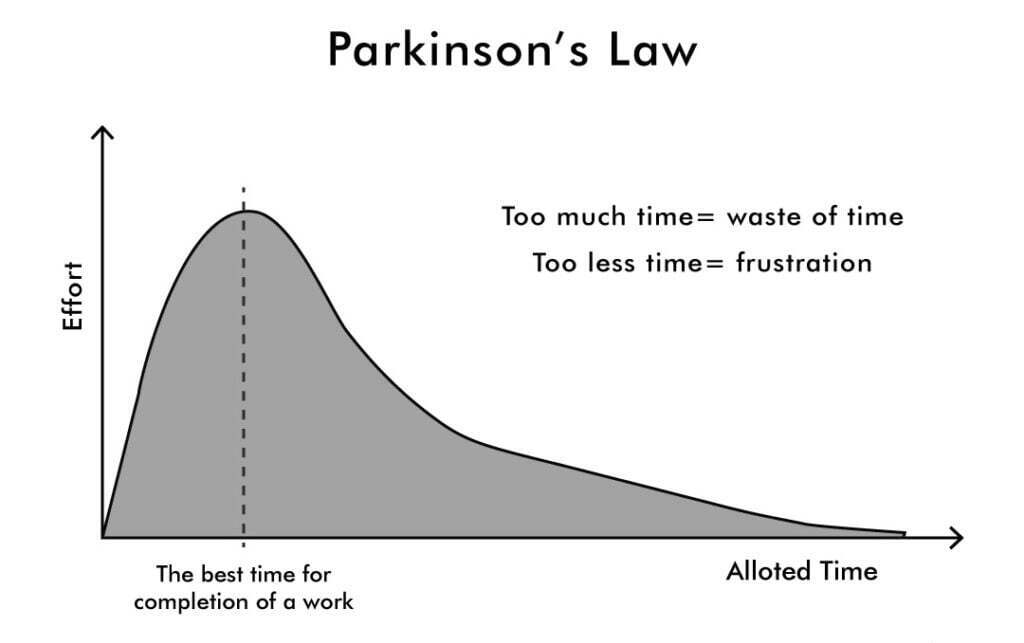Introduction
Parkinson’s Law, a captivating mental model, encapsulates the tendency for work to expand to fill the available time. Coined by British author Cyril Northcote Parkinson, this principle explains how tasks often take longer than necessary due to inefficiencies, procrastination, and poor time management. Although rooted in the realm of productivity, Parkinson’s Law permeates decision-making processes, exerting a profound influence on our personal and professional lives. By unraveling the psychological underpinnings and biases associated with this concept, we can enhance our decision-making abilities and avoid the trap of irrational choices that contradict our best interests.
Parkinson’s Law in Action: Examples from Various Contexts
- Personal Life Decisions: Consider an individual who sets a week to complete a relatively simple home improvement project. However, due to poor planning, distractions, and a lack of prioritization, the task stretches beyond the allocated time frame. In succumbing to Parkinson’s Law, the person experiences frustration, wasted resources, and delays in achieving their desired outcome.
- Business Scenarios: Within organizations, Parkinson’s Law manifests when a project’s timeline is extended due to scope creep and inefficient resource allocation. Teams may become complacent, allowing work to expand without setting clear deadlines or implementing effective project management practices. This leads to delays, increased costs, and missed opportunities for growth and innovation.
- Public Policy-Making: In the realm of public policy, Parkinson’s Law emerges when government agencies or legislative bodies fail to enact necessary reforms within reasonable time frames. Bureaucratic processes, red tape, and a lack of urgency can cause policies to linger in development, leading to delayed solutions for societal issues and an erosion of public trust.
Mental Biases and Underpinnings
Parkinson’s Law is intertwined with various mental biases that contribute to its prevalence in decision-making. One key bias is the Planning Fallacy, where individuals consistently underestimate the time and effort required to complete tasks. Optimism bias also plays a role, as people tend to believe they can accomplish more within a given timeframe than is realistically possible. Additionally, the Zeigarnik Effect, which highlights our tendency to remember unfinished tasks more vividly, can drive individuals to expand work beyond necessary boundaries.
Another contributing factor is the Procrastination Bias, where individuals delay important tasks and allocate insufficient time for their completion. Procrastination stems from our preference for short-term gratification over long-term success, leading to last-minute rushes and inefficient use of time. Moreover, the Anchoring Bias influences our perception of time, as initial estimates or deadlines can anchor our expectations, resulting in work expanding to match those predetermined parameters.
Identifying and Mitigating Parkinson’s Law
To mitigate the detrimental effects of Parkinson’s Law on decision-making, it is essential to recognize when it is at play and implement strategies to counteract its influence. Here are some practical tips:
- Set Realistic Deadlines: When establishing deadlines for tasks or projects, account for potential challenges, contingencies, and unexpected delays. Involve stakeholders and team members in the planning process to gain diverse perspectives and ensure a more accurate estimation of time requirements.
- Practice Effective Time Management: Implement time-management techniques such as prioritization, breaking tasks into smaller, manageable chunks, and setting aside dedicated time for focused work. Adopting productivity frameworks like the Pomodoro Technique or time-blocking can help structure your day and reduce the risk of work expanding unnecessarily.
- Foster Accountability and Feedback: Encourage a culture of accountability by establishing clear expectations, monitoring progress, and providing timely feedback. Regularly review and adjust plans, identifying inefficiencies and addressing challenges promptly to prevent work from ballooning beyond necessary limits.
- Combat Procrastination: Understand the root causes of procrastination and develop strategies to overcome it. Break tasks into smaller, actionable steps, create an environment conducive to concentration, and leverage techniques like visualization and positive reinforcement to motivate and maintain momentum.
Conclusion
Parkinson’s Law serves as a critical mental model that sheds light on the tendencies of work to expand beyond necessary limits. By recognizing its prevalence in decision-making processes and understanding the psychological biases that contribute to its manifestation, we can take proactive steps to mitigate its negative impact. Setting realistic deadlines, practicing effective time management, fostering accountability, and combating procrastination enable us to make more informed and efficient decisions. By actively avoiding the trap of Parkinson’s Law, we can optimize our productivity, achieve better outcomes, and maintain a healthy balance between work and personal life.
